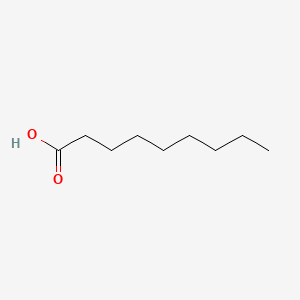| MeSH term | MeSH ID | Detail |
|---|---|---|
| Dermatitis, Contact | D003877 | 59 associated lipids |
| Facial Dermatoses | D005148 | 7 associated lipids |
| Hypersensitivity | D006967 | 22 associated lipids |
| Arteriosclerosis | D001161 | 86 associated lipids |
| Seizures | D012640 | 87 associated lipids |
| Dermatitis, Allergic Contact | D017449 | 20 associated lipids |
| Riboflavin Deficiency | D012257 | 10 associated lipids |
| Lichen Planus | D008010 | 3 associated lipids |
| Keratosis | D007642 | 9 associated lipids |
| Tick Infestations | D013984 | 4 associated lipids |
NONANOIC ACID
NONANOIC ACID is a lipid of Fatty Acyls (FA) class. Nonanoic acid is associated with abnormalities such as megalocytosis, Hypos, Renal tubular disorder, Respiratory Distress Syndrome, Adult and Little's Disease. The involved functions are known as Gene Expression, Signal Transduction, Regulation, Cell Cycle and Force. Nonanoic acid often locates in Membrane, Protoplasm, Body tissue, Extracellular and Cell membrane. The associated genes with NONANOIC ACID are cysteinylglycine, glycylsarcosine, arginine methyl ester, GLI3 gene and ADRBK1 gene. The related lipids are 1-octen-3-ol, Butyric Acids, palmitoleic acid, pentadecanoic acid and stearic acid.
Cross Reference
Introduction
To understand associated biological information of NONANOIC ACID, we collected biological information of abnormalities, associated pathways, cellular/molecular locations, biological functions, related genes/proteins, lipids and common seen animal/experimental models with organized paragraphs from literatures.
What diseases are associated with NONANOIC ACID?
NONANOIC ACID is suspected in megalocytosis, Hypos, Renal tubular disorder, Respiratory Distress Syndrome, Adult, Little's Disease and other diseases in descending order of the highest number of associated sentences.
Related references are mostly published in these journals:
- Am. J. Physiol. Renal Physiol. (1)
- Dis Model Mech (1)
- Am. J. Physiol. Heart Circ. Physiol. (1)
- Others (1)
| Disease | Cross reference | Weighted score | Related literature |
|---|
Possible diseases from mapped MeSH terms on references
We collected disease MeSH terms mapped to the references associated with NONANOIC ACID
PubChem Associated disorders and diseases
What pathways are associated with NONANOIC ACID
There are no associated biomedical information in the current reference collection.
PubChem Biomolecular Interactions and Pathways
Link to PubChem Biomolecular Interactions and PathwaysWhat cellular locations are associated with NONANOIC ACID?
Visualization in cellular structure
Associated locations are in red color. Not associated locations are in black.
Related references are published most in these journals:
- Am. J. Physiol. Heart Circ. Physiol. (4)
- Am. J. Physiol., Cell Physiol. (1)
- J. Appl. Physiol. (1)
- Others (6)
| Location | Cross reference | Weighted score | Related literatures |
|---|
What functions are associated with NONANOIC ACID?
Related references are published most in these journals:
| Function | Cross reference | Weighted score | Related literatures |
|---|
What lipids are associated with NONANOIC ACID?
Related references are published most in these journals:
| Lipid concept | Cross reference | Weighted score | Related literatures |
|---|
What genes are associated with NONANOIC ACID?
Related references are published most in these journals:
- Am. J. Physiol. Heart Circ. Physiol. (2)
- Am. J. Physiol. Lung Cell Mol. Physiol. (1)
- J. Biol. Chem. (1)
- Others (3)
| Gene | Cross reference | Weighted score | Related literatures |
|---|
What common seen animal models are associated with NONANOIC ACID?
There are no associated biomedical information in the current reference collection.
NCBI Entrez Crosslinks
All references with NONANOIC ACID
Download all related citations| Authors | Title | Published | Journal | PubMed Link |
|---|---|---|---|---|
| Levin CY and Maibach HI | Do cool water or physiologic saline compresses enhance resolution of experimentally-induced irritant contact dermatitis? | 2001 | Contact Derm. | pmid:11553140 |
| Nakama T et al. | Structural basis for the recognition of isoleucyl-adenylate and an antibiotic, mupirocin, by isoleucyl-tRNA synthetase. | 2001 | J. Biol. Chem. | pmid:11584022 |
| Kim DY et al. | Biosynthesis of polyhydroxyalkanoate copolyester containing cyclohexyl groups by Pseudomonas oleovorans. | 2001 | Int. J. Biol. Macromol. | pmid:11589966 |
| Zhang R et al. | A nitric oxide donor induces neurogenesis and reduces functional deficits after stroke in rats. | 2001 | Ann. Neurol. | pmid:11706966 |
| Tsai IL et al. | Cytotoxic butanolides from the stem bark of Formosan Lindera communis. | 2001 | Planta Med. | pmid:11745027 |
| Garthwaite G et al. | Soluble guanylyl cyclase activator YC-1 protects white matter axons from nitric oxide toxicity and metabolic stress, probably through Na(+) channel inhibition. | 2002 | Mol. Pharmacol. | pmid:11752210 |
| Kang HO et al. | Cometabolic biosynthesis of copolyesters consisting of 3-hydroxyvalerate and medium-chain-length 3-hydroxyalkanoates by Pseudomonas sp. DSY-82. | 2001 | Antonie Van Leeuwenhoek | pmid:11759051 |
| Garthwaite G et al. | Nitric oxide toxicity in CNS white matter: an in vitro study using rat optic nerve. | 2002 | Neuroscience | pmid:11784706 |
| Apel CL et al. | Self-assembled vesicles of monocarboxylic acids and alcohols: conditions for stability and for the encapsulation of biopolymers. | 2002 | Biochim. Biophys. Acta | pmid:11825583 |
| Renganathan M et al. | Nitric oxide blocks fast, slow, and persistent Na+ channels in C-type DRG neurons by S-nitrosylation. | 2002 | J. Neurophysiol. | pmid:11826045 |
